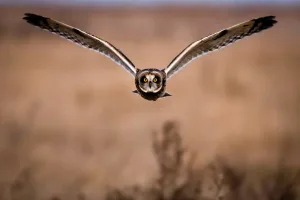26 Fun Facts About Chicken You Need to Know ASAP
-
Chickens establish a u0022pecking orderu0022 to maintain their social hierarchy.
-
Roosters perform a u0022tidbittingu0022 dance to attract hens.
-
Chickens have over 30 unique vocalizations for specific communication.
-
Hens may cluck to their unhatched chicks, who chirp back.
-
Some chicken breeds naturally lay blue or green eggs.
-
Chickens are omnivores and will eat a surprisingly wide diet.
-
Chickens evolved from dinosaurs and share a common ancestor with the T-Rex.
-
A chicken’s wattles help them regulate body temperature.
-
Chickens can feel empathy.
-
A mother hen will turn her eggs up to 50 times a day.
-
Chickens enjoy sunbathing for warmth and health.
-
Chicken eggshells are porous, allowing flavors to be absorbed during cooking.
-
Some chickens have feathers on their feet.
-
The fear of chickens is called Alektorophobia.
-
Chickens bob their heads while walking to help them stabilize their vision.
Table of Contents
1. The Surprising Truth Behind Chickens Laying Eggs Daily.
Did you know that chickens can lay eggs almost every single day? This frequent egg-laying is influenced by their evolutionary traits and breeding practices.
In the wild, chickens lay eggs to ensure species survival, but domesticated chickens are bred for maximum egg production. While a hen’s body is constantly in egg-laying mode, factors like light and food availability can influence this process.
2. Chickens Dream Just Like Humans Do!
Ever wonder if chickens dream? Studies show that chickens experience rapid eye movement (REM) sleep, the phase associated with dreaming in humans.
During this stage, chickens’ eyes twitch and their bodies move in a way that suggests they may be dreaming, just like we do! Their dreams might involve their daily activities, but we’ll never know for sure!
3. Why Chickens Don’t Mind Spicy Food Like Humans Do.
While humans tend to avoid spicy food due to its heat, chickens don’t react the same way. They can consume chili peppers without any discomfort because their taste buds aren’t as sensitive to capsaicin, the compound responsible for spiciness.
This ability allows chickens to eat a variety of foods that humans would find too hot to handle.
4. Chickens have been domesticated for around 8,000 years.
READ ALSO: 22 Fun Facts About Elephants | Trunks, Tusks, & Tales
Chickens have played a role in human societies for millennia, with evidence suggesting their domestication dates back at least 8,000 years. Initially raised for cockfighting rather than for food, their role in human life has evolved significantly over time.
Today, chickens are a staple in diets around the world, providing meat and eggs. Their long history with humans has made them one of the most ubiquitous domestic animals on the planet.
5. A chicken once survived without its head for 18 months.
In a bizarre turn of events, a chicken named Mike lived for 18 months after his head was chopped off. This strange tale occurred in the 1940s and has since become a part of chicken lore.
Mike’s survival was due to a precise cut that left most of his brain stem intact, allowing him to live for an extended period without a head. His story is often cited as an example of the incredible resilience of chickens.
6. Can Chickens Survive Without a Beak? Find Out!
Chickens rely heavily on their beaks for feeding, grooming, and communication. While it may seem impossible for a chicken to survive without a beak, some have adapted to this challenge.
Chickens without beaks are given special care in farms, as they cannot peck for food. However, with assistance, they can survive, but they need help to eat and drink properly.
7. How Chickens Use Over 30 Different Sounds to Communicate!
Chickens have a remarkable range of vocalizations. They can produce over 30 different sounds, each with its own specific meaning, such as alarm calls, mating calls, and feeding signals.
By using their vocalizations, chickens can communicate everything from warnings about predators to sharing the location of food with their flock. It’s a sophisticated system that helps them thrive in groups.
8. There are more chickens on Earth than any other bird species.

READ ALSO: 23 Fun Facts About Giraffe | Sky-High Elegance in Stripes
With billions of individuals worldwide, chickens outnumber every other species of bird on the planet. This is largely due to their importance to human agriculture and diet.
This fun facts about Chicken highlights not only their popularity but also their significance in human culture and economy. Their sheer numbers are a reflection of their role as a key food source globally.
9. The world’s oldest known chicken lived to be 16 years old.
While most chickens live much shorter lives, especially those raised for food, the world’s oldest chicken reached the ripe old age of 16. This exceptional age showcases the potential longevity of these birds under the right care.
The longevity of this particular chicken serves as a testament to the robustness and resilience of the species, defying common perceptions about their fragility.
10. The first bird to travel in space was a chicken.
In a somewhat quirky footnote to space exploration history, the first bird to ever travel in space was a chicken egg. This occurred during a 1961 NASA mission, marking a unique moment in the annals of space travel.
This event underscores the often-unexpected roles chickens have played in human history. From contributing to scientific research to becoming part of significant milestones like space exploration, chickens have been there.
11. How Chickens Lay Eggs Without a Rooster Around.
Many people mistakenly believe that a rooster is necessary for a hen to lay eggs. In reality, hens will lay eggs even without the presence of a rooster.
This is because the egg-laying process is part of the hen’s natural cycle, which is regulated by light and hormones, not fertilization.
12. Chickens can see more colors than humans.

READ ALSO: 26 Fun Facts About Pigeons You Should Know
Chickens have remarkable vision and can perceive a broader spectrum of colors than humans can. This visual acuity helps them detect food and predators more effectively.
Their ability to see ultraviolet light adds an extra dimension to their world, enhancing their interaction with their environment. It’s a fascinating aspect of their biology, showing how their perception differs from ours.
13. Chickens Have Been Trained to Play Video Games!
Believe it or not, chickens have been trained to play video games! In research studies, chickens were taught how to peck at a screen to play simple games like Pong.
This training demonstrates chickens’ ability to learn and interact with technology, showcasing their intelligence and adaptability.
14. The Most Expensive Chickens That Sold for Thousands!
Some rare breeds of chickens can fetch prices in the thousands! The Ayam Cemani, a rare Indonesian breed known for its all-black feathers, bones, and organs, is one of the most expensive chickens in the world.
This breed has become a status symbol, with some chickens being sold for as much as $2,500!
15. Chickens have been sent into space.
In the annals of space exploration, chickens have also played a part. They have been among the various organisms sent into space to study the effects of zero gravity on living beings. This fact highlights the wide-ranging impact chickens have had on scientific research.
These missions have provided valuable data on how living organisms can survive and behave in the unique conditions of space, demonstrating chickens’ contributions beyond just agriculture.
16. A chicken’s comb has a purpose beyond decoration.

READ ALSO: 26 Fun Facts About Crows | Clever Tricksters
The comb, often seen as merely decorative, plays a crucial role in a chicken’s life. It helps in thermoregulation, allowing chickens to release heat on hot days. This feature is vital for their survival and comfort.
Additionally, the size and color of the comb can be a sign of health and vitality, making it an important aspect of chicken behavior and social dynamics. It’s a prime example of how every part of the chicken has a functional role.
17. The largest chicken egg ever recorded weighed over 12 ounces.
Record-breaking in its size, the largest chicken egg ever recorded tipped the scales at over 12 ounces. This extraordinary egg showcases the range of sizes chicken eggs can achieve under certain conditions.
This fact not only astonishes but also illustrates the biological diversity within chicken breeds, with some capable of producing significantly larger eggs than others.
18. Chickens can live without a head for a short period.
One of the more macabre facts about Chicken is their ability to survive for a short time without their head, due to their brainstem controlling many basic life functions. This phenomenon has been observed in rare instances, contributing to some of the more unusual stories in chicken lore.
This ability, while not common, speaks to the resilience and basic biological design of chickens, allowing them to continue some bodily functions even after decapitation.
19. There are over 500 breeds of chickens.
With more than 500 breeds, chickens boast an incredible variety of sizes, colors, and characteristics. This diversity allows them to be raised for different purposes, from egg production to meat, or even as pets.
This wide array of breeds reflects the adaptability and widespread domestication of chickens across the world, each breed developed to meet specific human needs or environmental conditions.
20. Chickens use dust baths to stay clean.

READ ALSO: 24 Fun Facts About Sharks | The Apex Predators
Contrary to what one might think, chickens maintain their hygiene through dust baths. This behavior involves rolling in dirt to protect their feathers from parasites and maintain their skin health.
This natural instinct is an essential part of their grooming process, showcasing an interesting aspect of their behavior that keeps them healthy and comfortable without needing water baths.
21. Chickens have been depicted in human art for centuries.
Chickens have not only been companions and food sources for humans but have also featured in our art and stories for centuries. They are symbols of fertility, bravery, and motherhood in various cultures.
This enduring presence in human culture highlights their importance and the deep connections humans have formed with chickens throughout history, celebrating their role in society beyond mere agricultural value.
22. What does the nutrition label on chicken tell me?
The nutrition label provides information on calories, fat (including saturated fat), cholesterol, sodium, protein, and important vitamins and minerals per serving.
23. A chicken’s vision is better than humans in some aspects.
Chickens have remarkable eyesight; their vision surpasses human capabilities in detecting movement and subtle shades of color, especially in the ultraviolet spectrum. This keen vision helps them find food and avoid predators.
Their ability to see ultraviolet light gives them a view of the world that is vastly different from our own, illustrating the fascinating ways in which evolution has tailored species to their specific environmental needs.
24. How Chickens Are Related to the Mighty T. Rex!

READ ALSO: 26 Fun Facts About Beavers | Nature’s Engineers
Chickens might seem far removed from prehistoric giants, but they actually share a distant common ancestor with the mighty Tyrannosaurus rex! This revelation comes from extensive studies of their skeletal structure and DNA.
Researchers found that birds, including chickens, are the closest living relatives of dinosaurs, particularly theropods like the T. rex. Isn’t it mind-blowing that your backyard chicken has a link to one of the most feared predators of all time?
25. Why Do Roosters Don’t Just Crow at Dawn?
It’s a common myth that roosters crow only at the crack of dawn, but that’s not entirely true. Roosters can crow at any time of day, and their crowing has much more to do with territory and social hierarchy than it does with sunrise.
Roosters are known to crow to announce their presence and establish dominance. So, if you hear a rooster crowing at noon, don’t be too surprised—he’s just doing his job!
26. The Incredible Ability of Chickens to Sense Earthquakes!
Chickens, along with other animals, are believed to have a unique ability to sense earthquakes before they happen. They often exhibit unusual behaviors, like restlessness or vocalizing, just before seismic activity begins.
This natural earthquake detection system has been reported by many farmers, though it remains a mystery how chickens can perceive such events.
FAQs
Chickens are surprisingly fast runners, reaching speeds of up to 9 miles per hour. This speed helps them escape predators quickly, even though they are not known for their stamina.
Chickens have excellent color vision, even better than humans. They can see a broad range of colors, including ultraviolet light, which allows them to detect things that are invisible to us.
Yes, chickens can recognize and remember up to 100 faces. This ability plays a significant role in their social interactions, allowing them to differentiate between different chickens and humans in their environment.
Chickens do dream, just like humans, during the REM (Rapid Eye Movement) phase of their sleep cycle. This suggests that they may experience dreams or process experiences and memories during this time.
Yes, chickens can recognize their owners and often show affection or excitement when they see them. They are capable of forming bonds with people, much like pets such as dogs and cats.





